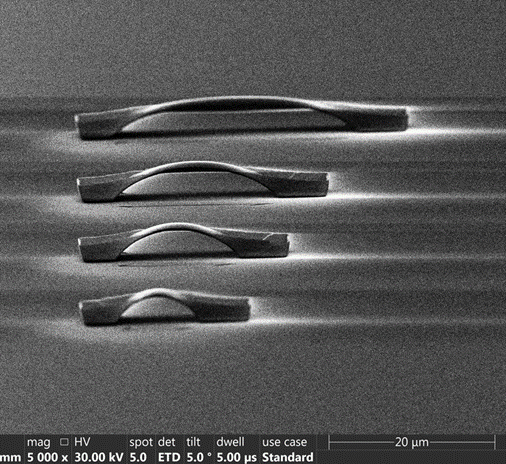Microelectronics and, in particular, superconducting quantum processors increasingly depend upon 3D metal structures to overcome constraints of purely planar, 2D microfabrication on low-loss dielectric surfaces (such as sapphire or silicon). Within superconducting qubit devices, the most common example are airbridges that allow for electrical pathways to be routed up and over other electrical pathways. In the superconducting qubit space, these airbridges are commonly made from high purity aluminum or titanium.
To microfabricate these 3D structures, it is common to use one or more layers of polymer photoresist, which can be readily patterned into an arbitrary shape. That shape is then transferred to the metal by depositing a layer of metal on top of the resist and then removing the resist by chemical treatment. The drawback of this technique is contamination – the product always includes some carbon-containing residue which can be detrimental to performance. The most aggressive common treatment to remove such residues is a 'Piranha etch' solution (a mixture of sulfuric acid and hydrogen peroxide), and as the name implies, it can dissolve many things including most metals, such as aluminum and titanium.
Tantalum has excellent electronic and mechanical properties and can withstand such strong corrosive mixtures. Moreover, its relatively high superconducting temperature (4.3 K) and superior surface qualities make it suitable for low-loss superconducting channels, such as those in superconducting qubit processors. But making films with high conductivity (the bcc phase of the crystal) typically requires temperatures more than 500 °C, which will deteriorate any polymer resist structure.
LLNL researchers developed a novel method to nucleate the alpha phase of Tantalum on a polymer surface at room temperature, allowing for the controllable formation of a variety of 3D structures, such as airbridges. Using this method with a subsequent Piranha etch results in the complete removal of the residues of the polymer 'scaffolding' or template while allowing the deposited tantalum structure to remain intact. The crystal structure of the material (alpha-phase) was determined by analysis of its resistivity and microscopic morphology.
Image Caption: SEM image of tantalum airbridges
Loren D. Alegria, Daniel M. Tennant, Kevin R. Chaves, Jonathan R. I. Lee, Sean R. O'Kelley, Yaniv J. Rosen, Jonathan L. DuBois; Two-level systems in nucleated and non-nucleated epitaxial alpha-tantalum films. Appl. Phys. Lett. 7 August 2023; 123 (6): 062601 (https://doi.org/10.1063/5.0157654).
- Room temperature deposition of alpha phase tantalum 3D structures or arbitrary form factor.
- Chemical etching resistance allows for complete removal of polymer template after tantalum deposition.
- Formation of alpha-phase tantalum provides the resulting structures with added structural integrity and improved electrical properties.
- Qubit design
- Semiconductor wafer component manufacturing
Current stage of technology development: TRL 3


